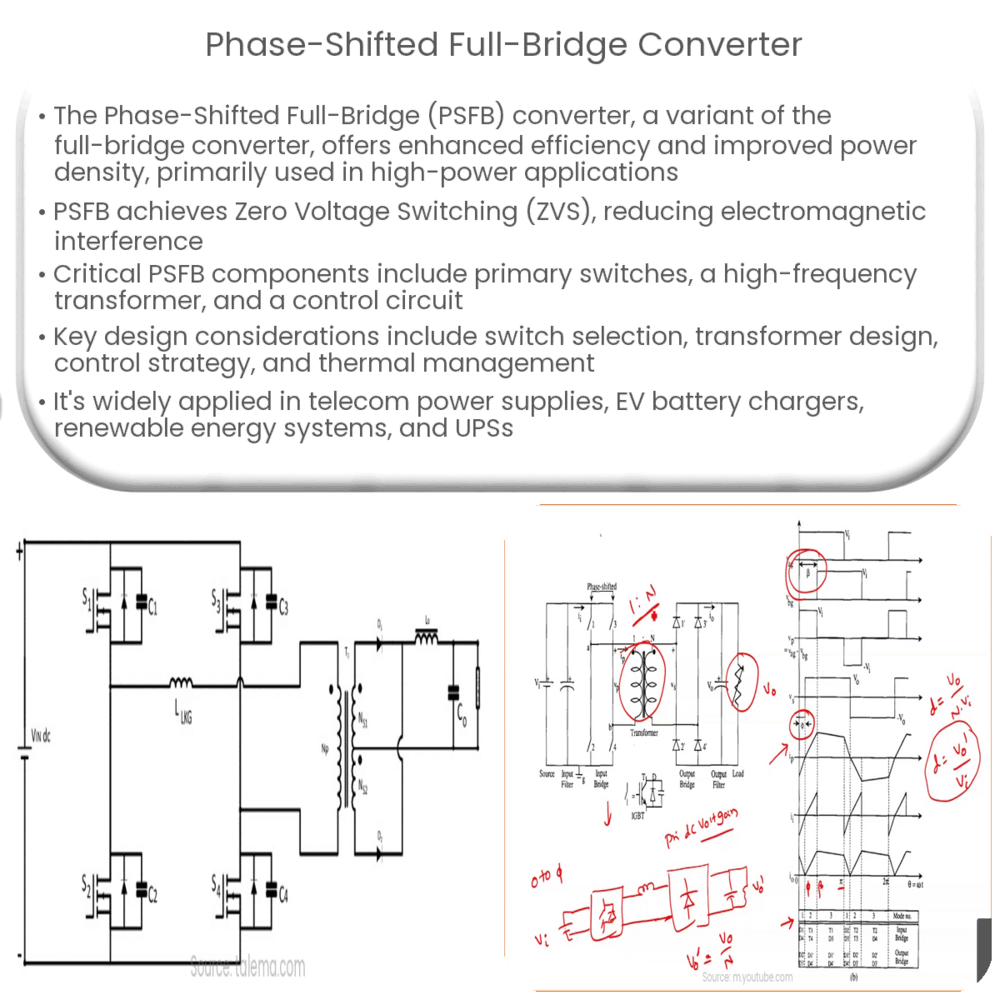The phase-shifted full-bridge converter is a high-efficiency power electronic topology used in various applications, featuring reduced component stress and lower EMI.

Phase-Shifted Full-Bridge Converter: An In-Depth Introduction
Overview of the Full-Bridge Converter
The full-bridge converter is a widely used topology in power electronics, offering the advantages of high efficiency and voltage conversion capability. It is commonly employed in applications such as DC-DC converters, inverters, and uninterruptible power supplies. A full-bridge converter consists of four switches arranged in an H-bridge configuration, with two primary and two secondary windings on a transformer, allowing for bidirectional power flow between the input and output sides.
Phase-Shifted Full-Bridge Converter: A Modern Approach
As a variation of the traditional full-bridge converter, the phase-shifted full-bridge (PSFB) converter is a popular choice in high-power applications due to its enhanced efficiency, reduced component stress, and improved power density. By incorporating phase-shifting techniques, the PSFB converter achieves Zero Voltage Switching (ZVS) in the primary side switches, which minimizes switching losses and reduces electromagnetic interference (EMI).
Key Components of the Phase-Shifted Full-Bridge Converter
The primary elements of the PSFB converter include:
- Four primary side switches: These switches are typically implemented using power MOSFETs or IGBTs and are arranged in an H-bridge configuration.
- High-frequency transformer: The transformer serves as the central component for voltage conversion and isolation between the input and output stages of the converter.
- Output rectification stage: Diodes or synchronous rectifiers are used to convert the transformer’s secondary side AC voltage into a DC output voltage.
- Output filter: An output inductor and capacitor filter the rectified voltage, providing a stable and smooth output voltage to the load.
- Control circuit: The control circuit, often implemented with a PWM controller, is responsible for regulating the converter’s output voltage by adjusting the phase shift between primary side switches.
Operation and Benefits of the Phase-Shifted Full-Bridge Converter
The PSFB converter operates by modulating the phase angle between the primary side switches, resulting in ZVS. This is achieved by controlling the time delay between turning off one pair of switches and turning on the other pair. When the delay is appropriately set, the energy stored in the transformer’s leakage inductance is used to discharge the capacitive energy stored in the switch, causing the voltage across the switch to drop to zero before it is turned on. This ZVS operation reduces switching losses and improves overall efficiency.
Some key benefits of the PSFB converter include:
- Higher efficiency: ZVS operation minimizes switching losses and allows for higher operating frequencies, leading to smaller passive components and improved power density.
- Reduced component stress: The ZVS technique reduces voltage and current stress on the switches, prolonging their lifespan and increasing overall converter reliability.
- Lower EMI: The reduction in switching losses also results in decreased EMI, simplifying EMI filter design and potentially reducing system costs.
Design Considerations for Phase-Shifted Full-Bridge Converters
When designing a PSFB converter, there are several factors to consider:
- Switch selection: Choosing the appropriate power switches (MOSFETs or IGBTs) for the primary side is crucial, as it influences the efficiency and overall performance of the converter. Considerations include voltage and current ratings, switching speeds, and thermal performance.
- Transformer design: The high-frequency transformer must be designed for optimal performance, taking into account parameters such as core material, turns ratio, and leakage inductance. Proper transformer design ensures efficient energy transfer and minimizes losses.
- Control strategy: The control circuit should be capable of accurately adjusting the phase shift between primary side switches to achieve ZVS. A well-designed control strategy will ensure stable output voltage regulation under varying load conditions.
- Thermal management: As with any power electronic converter, proper thermal management is essential for reliable operation. This includes adequate heatsinking for power switches and consideration of component placement to minimize thermal coupling.
Applications of Phase-Shifted Full-Bridge Converters
The PSFB converter has found widespread use in various high-power applications, such as:
- Telecom power supplies: With their high efficiency and power density, PSFB converters are ideal for powering telecommunications equipment, including base stations and data centers.
- Electric vehicle battery chargers: PSFB converters can be used in on-board and off-board battery chargers for electric vehicles, offering fast charging capabilities with minimal energy loss.
- Renewable energy systems: PSFB converters are employed in solar and wind energy systems, where their high efficiency and reliability are crucial for maximizing energy harvesting and conversion.
- Uninterruptible power supplies (UPS): The PSFB converter’s high efficiency and reliability make it an attractive choice for UPS systems, ensuring continuous power delivery to critical loads during power outages.
Conclusion
The phase-shifted full-bridge converter offers numerous benefits, including higher efficiency, reduced component stress, and lower EMI. By employing phase-shifting techniques to achieve Zero Voltage Switching, the PSFB converter has become a popular choice in high-power applications, such as telecommunications, electric vehicle charging, renewable energy systems, and uninterruptible power supplies. When designing a PSFB converter, careful consideration must be given to switch selection, transformer design, control strategy, and thermal management to ensure optimal performance and reliability.

